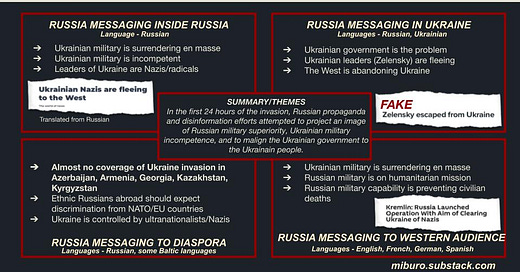Russia's Lies in Four Directions: The Kremlin's Strategy to Misinform About Ukraine
Many messages targeting many audiences
In recent years, a vast network of Kremlin propaganda outlets, fake social media accounts, and disinformation campaigns have been revealed to unwitting audiences in America and Europe. Western observers now increasingly ask “What’s Russia saying?,” “Is this from a troll?,” or “Are these Russian bots?” The answer is a bit more nuanced than a simple yes or no, this or that. On any given day, Russia broadcasts many messages in many directions. Since Russia invaded Ukraine just a few days ago, Kremlin propagandists have moved far beyond the fake accounts and internet trolls of past elections to try and shape perceptions and achieve information objectives with at least four different audiences.
Since the onset of its military build-up on Ukraine’s borders, Russia has maintained an information onslaught which culminated in the invasion of Ukraine on February 24. Has it worked? The answer depends on which language, which platform, and which target audience we are talking about. While the Kremlin’s many obvious provocations and its lies attempting to justify further incursion haven’t landed in the West, they’ve seemingly been a bit more successful in shaping Russian audiences. We’ve outlined at least four distinct audiences the Kremlin seeks to manipulate through falsehoods with regard to Russia’s invasion of Ukraine:
The domestic Russian audience;
Audiences inside Ukraine;
Audiences in former Soviet republics; and
Audiences in Western Europe and the U.S.
To the Russian audience at home and in the Russian-speaking diaspora, President Vladimir Putin and his government are trying to portray an image of military strength and reinforcement of a central disinformation line—namely the bogus claim that Ukraine’s President Volodymyr Zelensky, despite his Jewish heritage, is a “neo-Nazi” and a threat to Russian security.
Meanwhile, in many of the former Soviet republics, Russian media seems to be ignoring the situation in Ukraine, relying on total control of the information space to block the evidence of the Russian invasion rather than seeking to drown out any competing coverage.
Inside Ukraine, propagandists on the ground and covert social media accounts in Ukrainian Facebook groups and on social media app VKontakte (VK) amplify false claims that Ukrainian leaders have fled the country, Ukrainian forces are provoking military conflict, or that the West has abandoned Ukraine.
To the rest of the world, Russia tries to paint the Ukrainian government as war criminals and drug addicts who are somehow further escalating a war that, as a matter of fact, Russia alone has started.
Despite the Kremlin’s attempts to weaponize the information space through the spread of disinformation and to dehumanize Ukrainians via information campaigns, Russia’s messaging has been challenged in every audience space and achieved few discernible victories. Even at home, where the Kremlin dominates what is seen and heard, Russians have taken to the streets to protest Putin’s brutal assault on Ukraine; in countries like Georgia, protesters have demonstrated in opposition to Russia as well.
At the same time, both independent researchers and government agencies have seemingly decided enough is enough. At long last, and after years of struggling to catch up to Russian information warfare, the world has responded and is fighting back.



